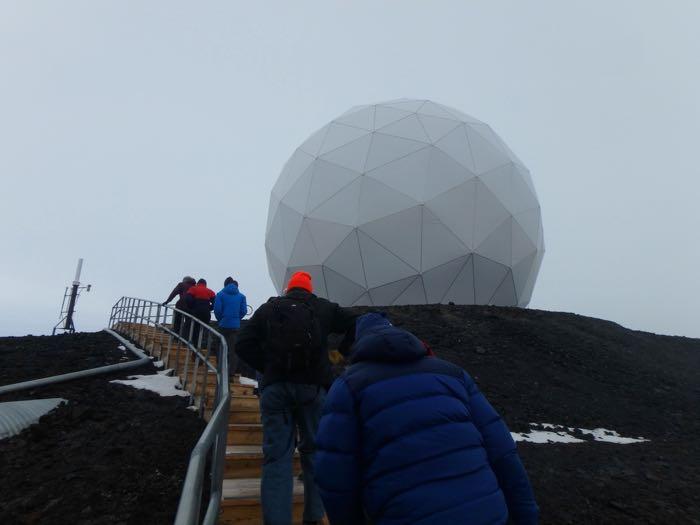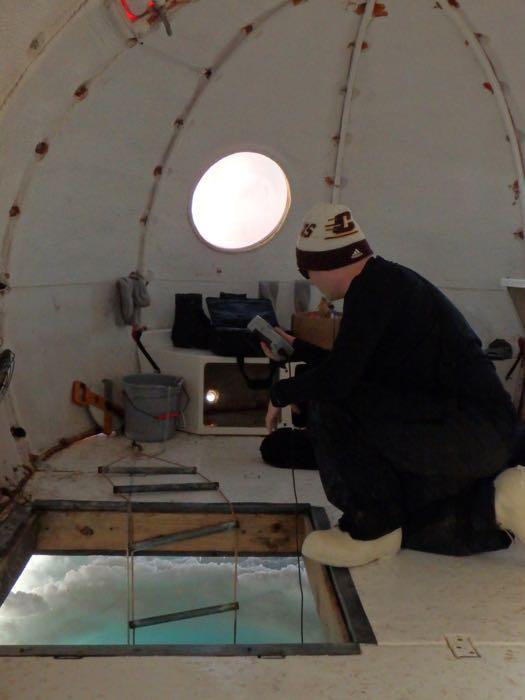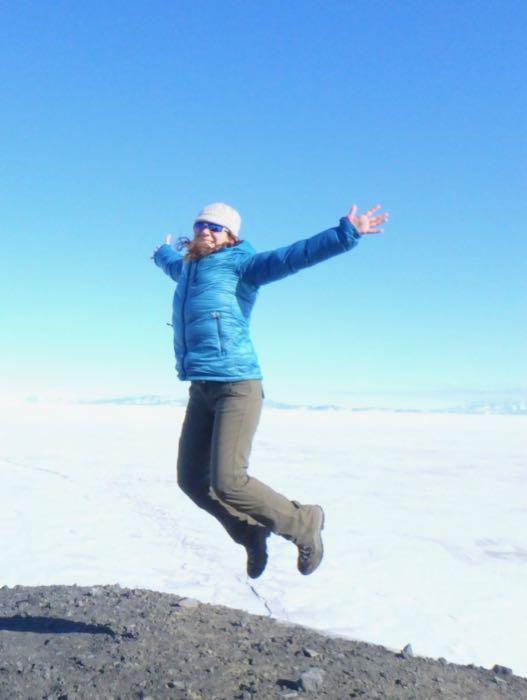(thanks Bill Watterson author and illustrator of Calvin & Hobbes for today's journal title!)
AN ODE TO THE COLD
It stings my lips and bites my cheeks
I think my fingers have been numb for weeks
Despite the sometimes gray and dingy days
The cold always makes me want to play
I spin through the white snow's falling flakes
Cold! Thank you for making me feel so awake!
It's poetry Friday! This week's poem is an Ode. An ode addresses a specific person, thing, or event. They don't have to rhyme. (I love rhyming so I made mine rhyme!) What's your favorite type of weather? Submit your ode below in the comments section!
My face stings as soon as I open the door and slide my sunglasses on to keep the wind from making my eyes water. "It feels like we are in...Antarctica!" my friend says. Yikes! Yes it does, wait...we are in Antarctica!
When I first arrived in Antarctica the skies were blue and clear. For weeks after I arrived, McMurdo Station was having what the folks in Wyoming call "Bluebird days". I wouldn't call it warm but it definitely didn't feel extremely cold. It made me wonder, as I sauntered between buildings barely wearing my jacket, why'd they even give us Extreme Cold Weather gear? It isn't THAT extreme. I enjoyed beautiful days standing outside of the dive hut during diving days, booking across the snow on a snowmobile with no need to use the heated handles, and leaving my big red parka hanging lonely on a hook.
 Aaron Toh, Graham Lobert, Amy Moran, and Amy Osborne (Left-Right) jumping during a sunny day on the sea ice. Ross Sea, near Cape Evans Wall, Antarctica
Aaron Toh, Graham Lobert, Amy Moran, and Amy Osborne (Left-Right) jumping during a sunny day on the sea ice. Ross Sea, near Cape Evans Wall, Antarctica
Antarctica wouldn't let me get too comfortable though. The past few days have brought colder temperatures and snow! I was so excited to see flakes dropping from the sky, I jumped for joy. My sauntering has changed to dashing between buildings and into the Pisten Bully. The wind has forced me to hold onto my winter hat and use my whole body to keep the Pisten Bully doors open.
Today it's -18°C, 0°F but with the wind chill it's -32°C (-25°F) with winds at 22knots (25mph) gusting to 27 knots (31mph). Though the cold has rushed back in, unfortunately, the ice has been thinning so our heavier, sturdier, warmer dive huts are being pulled for the lighter huts called apples or tomatoes. They provide shelter from the wind but aren't nearly as warm as the other huts.
 The divers' Pisten Bully driving back to McMurdo Station during a gray, cold, and windy day. McMurdo Station, Antarctica
The divers' Pisten Bully driving back to McMurdo Station during a gray, cold, and windy day. McMurdo Station, Antarctica
 This dive hut, being towed by a Pisten Bully across the sea ice, is known as an apple or tomato around the station. It is lighter so can sit on thinner ice than the other huts. It also has more drafty spaces, doesn't have a kuma stove, has fewer windows, is less insulated than the other huts so it is colder. Ross Sea near McMurdo Station, Antarctica.
This dive hut, being towed by a Pisten Bully across the sea ice, is known as an apple or tomato around the station. It is lighter so can sit on thinner ice than the other huts. It also has more drafty spaces, doesn't have a kuma stove, has fewer windows, is less insulated than the other huts so it is colder. Ross Sea near McMurdo Station, Antarctica.
Addie, Evie, and Rowan were wondering about the temperatures around here. What are the extremes? The lowest temperature ever recorded on earth was at Vostok Station in Antarctica on July 21, 1983. It was -89.2°C (-128.56°F)! I can't even imagine that kind of cold! I think that's a stay inside kind of day. The strongest wind gusts recorded are over 200km/hour (230mph). The warmest temperature on the continent was recorded on the Antarctic Peninsula at the Argentine Research Base Esperanza. On March 24, 2015 it was 17.5°C (63.5°F)
I enjoy this cold though. I'm much more of a cold weather person than a hot weather person.
Reesha was wondering what a scientist's days look like. So, what does a typical day look like during the chilly days of an Antarctic summer? Well, no matter the weather there's always a lot to be done!
Non-diving day
- I've only had one of these this week.
6:00am Wake up (sometimes I get up earlier and work out in the gym that's a 5 minute walk from my dorm. Occasionally I have an outreach skype appointment at 5:30 or 6am) Dr. Amy Moran gets up and gets to breakfast and work earlier than I do!
6:45am Breakfast in the galley. Fresh fruit just came in on yesterday's flight. That means kiwis, oranges, bananas, and apples. YAY!!!
 Fresh fruit arrived yesterday. YAY! McMurdo station's fresh fruits and vegetables are flown in as cargo from New Zealand. When it arrives everyone is excited! McMurdo Station, Antarctica
Fresh fruit arrived yesterday. YAY! McMurdo station's fresh fruits and vegetables are flown in as cargo from New Zealand. When it arrives everyone is excited! McMurdo Station, Antarctica
7:30am Start working: start writing a journal or making a movie or go and observe the animals in the lab
8:30am-9:00am Find team and find out if there are things I can do to help. Graham and Aaron usually show up around 8:30am. Amy has usually been in the lab well before this time!
9:00am-11:00am Help out team or research and write journal draft or talk to folks in the Crary Lab to find out more about what they are doing. Recently there were two artists, Ian Van Coller and Todd Anderson, sharing "study hall" space. Check out their amazing artwork by checking out their recent project: The Last Glacier Aaron, Graham, and Amy are usually running experiments, setting up new experiments, observing what's happening in their experiments, or, like today, looking at the data from the experiments to see what's going on.
 Aaron Toh uses a computer to help graph data he has collected. McMurdo Station, Antarctica
Aaron Toh uses a computer to help graph data he has collected. McMurdo Station, Antarctica
 Amy Osborne using a microbalance to determine the weight of eggs. This is just one of many steps to determine the ash free dry weight-which is how much the organic contents of the eggs weighs.
Amy Osborne using a microbalance to determine the weight of eggs. This is just one of many steps to determine the ash free dry weight-which is how much the organic contents of the eggs weighs.
11:00am Diver lunch (The divers like to get to the meals as soon as they start)
11:45am Usually by this time something has come up that I need or want to do. Some fun/learning things that have come up: go fishing with Anne's team, help Aaron and Graham and learn more about the experiments we are doing, dive tend a quick dive to the Jetty, attend a training or workshop to learn more about something around McMurdo. I've attended hut guide trainings, learned more about NASA and what they are doing here, launched a weather balloon, and I'm hoping to end up on a tour of the waste water treatment plant and the de-salinization plant! If I don't end up doing something I can often finish my journal by 6pm! (Today I helped Aaron and Graham identify stages of Ammothea eggs)
 TV screen that shows the paths of the satellites that pass overhead. McMurdo Station, Antarctica
TV screen that shows the paths of the satellites that pass overhead. McMurdo Station, Antarctica
 We took a field trip to find out: What's inside this dome? A satellite! McMurdo Station, Antarctica
We took a field trip to find out: What's inside this dome? A satellite! McMurdo Station, Antarctica
 Amy Osborne standing in front of a satellite dish near McMurdo Station, Antarctica. These dishes receive information from satellites that pass overhead. Because of it's location near the south pole, every satellite in space passes overhead. Each satellite passes every 12 hours and its data is gathered by this satellite dish. McMurdo Station, Antarctica
Amy Osborne standing in front of a satellite dish near McMurdo Station, Antarctica. These dishes receive information from satellites that pass overhead. Because of it's location near the south pole, every satellite in space passes overhead. Each satellite passes every 12 hours and its data is gathered by this satellite dish. McMurdo Station, Antarctica
 Amy Osborne with her hut guide bag standing near Scott's Discovery (1901-1903) hut, near McMurdo Station, Antarctica
Amy Osborne with her hut guide bag standing near Scott's Discovery (1901-1903) hut, near McMurdo Station, Antarctica
 Amy Osborne and Denise Hardoy fishing to gather fish for Anne Todgham's research. Jetty Dive Hut near McMurdo Station, Antarctica.
Amy Osborne and Denise Hardoy fishing to gather fish for Anne Todgham's research. Jetty Dive Hut near McMurdo Station, Antarctica.
5:00pm Diver dinner
Evening time: If it's Wednesday or Sunday there is a science talk at night that our whole team usually attends to learn more about what's happening with other research around here. This past Wednesday the Weddell seal team shared what they are doing, including some of their data, with us! If it's a Thursday I can get on a shuttle and go to Scott Base to visit their really awesome gift shop where they have great postcards and meet some kiwis. There is also a room that shows movies and trivia nights. Often in the evenings I'm still working on writing my journals and the rest of the research team is working on their experiments. (That's what is happening right now)
 Aaron Toh replenishes new water into trays of Ammothea eggs. Crary Lab, McMurdo Station, Antarctica.
Aaron Toh replenishes new water into trays of Ammothea eggs. Crary Lab, McMurdo Station, Antarctica.
11:00pm-1:00am Go to sleep. This just depends on how far along we all are on our work. Sometimes I'm up until 1:00am finishing journals or trying to finish up and upload videos. (Videos can't be uploaded during the day because there just isn't enough bandwidth!)
DIVE DAY!
These are my favorite days because I get to wander out to the sea ice! There are usually 4 or 5 dive days in a week.
6:00am Wake up and pack up Extreme Cold Weather gear
6:45am breakfast in the Galley-make sure to have a lunch to go! (There is a grab and go fridge where there are leftovers I can take with me. There's also a place to make sandwiches)
 There are cookies at every meal which are nice to pack up for a lunch on the ice. My favorite is peanut butter! McMurdo Station, Antarctica
There are cookies at every meal which are nice to pack up for a lunch on the ice. My favorite is peanut butter! McMurdo Station, Antarctica
7:30am Check email and start heating up water for and filling thermoses
8:10am Get ready to go...put on Extreme Cold Weather gear, grab Extreme Cold Weather bag and food box with thermoses
8:25am Be at dive locker ready to go
 Part of the dive locker where the regulators are stored. Dive Locker, McMurdo Station, Antarctica
Part of the dive locker where the regulators are stored. Dive Locker, McMurdo Station, Antarctica
8:30am Be in Pisten Bully. I'm usually riding with Aaron and Graham and I either drive or sit in the passenger seat up front. I wind up with some pretty great views! We all usually listen to music/podcasts on our headphones.
10:30ish Arrive at dive site. How long it takes to get there depends on where we are going. We always head north and go as far as Cape Evans or as close at Turtle Rock. Together we haul everything into the hut-oxygen tanks, dive bags, food, thermoses of hot water. Sometimes the hole needs to be cleared out.
 Graham Lobert and Rob Robbins cut and clear ice out of a dive hole. Since the tomato/apple huts are much colder the dive holes often freeze over
Graham Lobert and Rob Robbins cut and clear ice out of a dive hole. Since the tomato/apple huts are much colder the dive holes often freeze over
11:30ish Divers go in water. Graham and I record Oxygen percentages, salinity, and temperature of water. If we are in a hut with a working kuma stove we heat lunch for everyone. One of us always keeps and eye on the dive hole. When we see a lot of bubbles rising we know it's time to spring into action.
 Graham Lobert helps Aaron Toh with his flashlight and collecting container. Dive hut, Ross Sea, Antarctica
Graham Lobert helps Aaron Toh with his flashlight and collecting container. Dive hut, Ross Sea, Antarctica
 Graham Lobert in the tomato hut recording information about the temperature and oxygen content of the water.
Graham Lobert in the tomato hut recording information about the temperature and oxygen content of the water.
12:00ish Divers come up cold and wet. Graham grabs their oxygen tanks, I grab their fins. We have lunch and hot chocolate.
 Steve Rupp, Amy Moran, and Rob Robbins drinking hot chocolate between dives. Ross Sea near Evans Wall, Antarctica
Steve Rupp, Amy Moran, and Rob Robbins drinking hot chocolate between dives. Ross Sea near Evans Wall, Antarctica
12:45ish Divers go back in the water for a second dive. A couple of times I've done a plankton tow. The second dive is often a bit shorter.
1:00ish Divers come out of the water...more hot chocolate, more food. We haul the gear back into the Pisten Bullys.
2:30ish Head back across the bumpy sea ice to McMurdo
Ideally before 5: Arrive back at McMurdo. Unload gear and put it in dive locker shower. The divers rinse the salty water off of their gear.
5:00pm Diver dinner!
Evening time: same as above
We work 7 days a week and I love all of my days in Antarctica because they are always busy. I brought art supplies and books with me but I've barely touched them. There's always something to see, do, or write or make a movie about! I can't believe I have only 11 days left in this wonderful place. As always comments and questions are welcome below!
 YAY! Amy Osborne loves her days in Antarctica. Discovery Hut Point near McMurdo Station, Antarctica
YAY! Amy Osborne loves her days in Antarctica. Discovery Hut Point near McMurdo Station, Antarctica
Don't forget...
YOU CAN JOIN ME LIVE FROM MCMURDO STATION IN ANTARCTICA!
This will be a 45 minute to 1 hour live presentation and conversation. Ideally, you can attend for the whole time but please attend for the amount you can anyway! All are welcome to join! It will be geared towards K-12 classrooms so be sure to tell your teacher friends, or if you are a teacher please join in!!!
When: November 22, 2019 8:30 AM AKST (9:30 AM PST, 10:30 AM MST, 11:30 AM CST, 12:30 PM EST)
How: You need to register for the event by clicking HERE. You'll need to select November 22 Amy Osborne under Event Choice.
I hope you can join me!!
Also, don't forget to answer the trivia questions from November 8th Going Down to Find the Stars post. You can end up with a postcard from Antarctica!
Submit your answers by 5pm Pacific Time Friday, November 15th for a chance to receive a postcard from Antarctica!


Comments
Add new comment